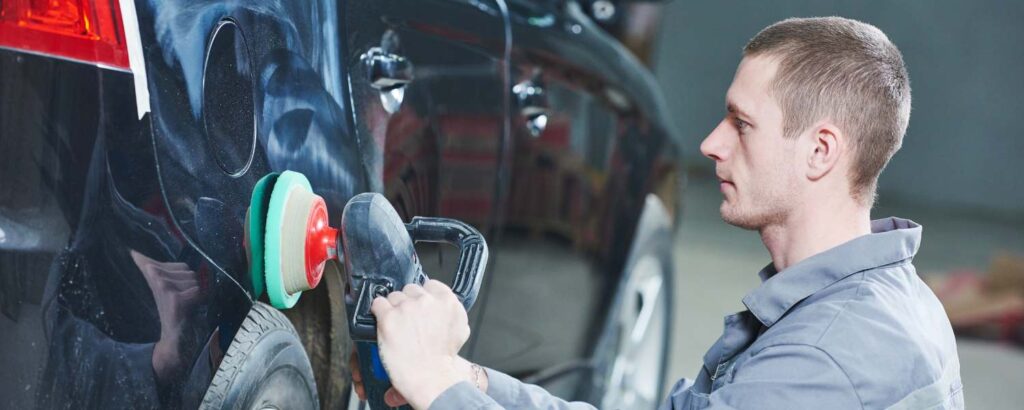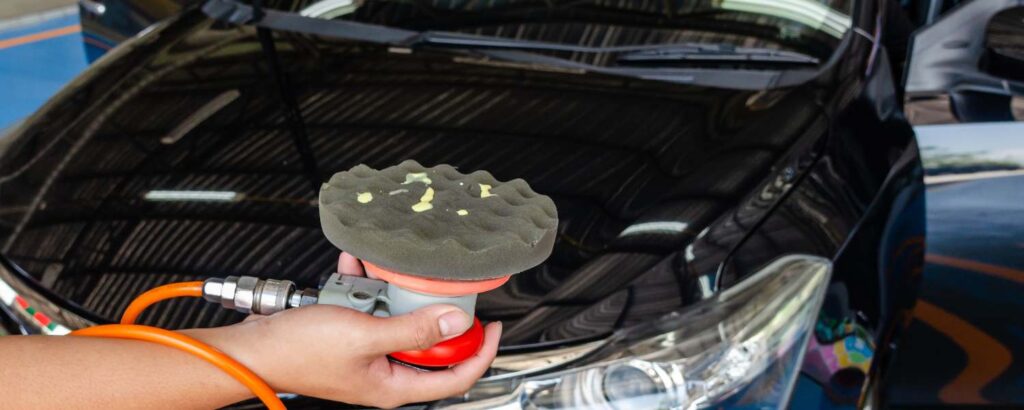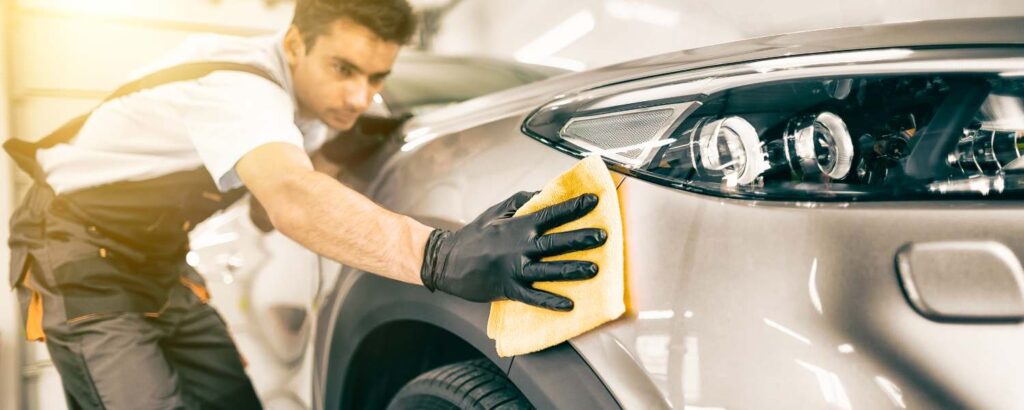Having a car isn’t just about going from one place to another; it’s also about feeling proud of how your vehicle looks. A well-maintained car not only performs better but also looks better. One crucial aspect of car maintenance is polishing. Car polishing is not just reserved for auto enthusiasts or professional detailers; it’s an essential practice for anyone who wants to keep their car looking as good as new.
Why polish your car?

Before diving into the frequency of car polishing, let’s understand why it’s essential. Car polishing is a process that involves the application of a specially formulated polish to the vehicle’s exterior to remove imperfections, restore shine, and protect the paint. Over time, a car’s paint can suffer from various issues, such as swirl marks, oxidation, and minor scratches. Polishing helps address these problems, ensuring your car maintains its aesthetic appeal.
Preserving your car’s lustrous appearance goes beyond regular washing; it involves thoughtful practices like polishing. One key consideration is determining how often you should polish your car to balance aesthetic appeal and protective care.
In addition to polishing, incorporating other detailing techniques can significantly enhance your car’s overall sparkle. how to use clay bar for a car is a really important step in the detailing process, as it helps remove embedded contaminants from the paint, ensuring a smoother and cleaner surface. This step is particularly important before polishing to maximize its effectiveness.
Furthermore, your car’s interior plays a significant role in its overall appeal. Regularly cleaning leather car seats maintains their luxurious look and contributes to a more comfortable driving experience. A comprehensive approach also involves a thorough wash interior car routine, addressing surfaces beyond the seats for a pristine inside environment.
For those seeking professional assistance, services like mobile detailing in Seattle offer convenient solutions to keep your car in top-notch condition. Mobile detailing brings the expertise directly to you, making sure your vehicle gets the attention it needs without the inconvenience of going to a detailing shop.
How to Polish a Car

Before delving into how often you should polish your car, knowing the correct way to do it is crucial. Here’s a step-by-step guide on how to polish a car effectively:
1. Prepare the Surface
Before diving into the car polishing process, ensuring the surface is impeccably clean is crucial. Start washing your car thoroughly to eliminate dirt, grime, and other contaminants. This first step is crucial to getting your car polished just right. It makes sure the surface is clean and ready for the polish to do its job and make your car look great.
2. Choose the Right Polish
Selecting the appropriate car polish is paramount to achieving the desired results. Different paints require specific formulations, so choose a high-quality polish that matches your car’s paint type. Whether it’s a clear coat, single-stage paint, or metallic finish, using the right polish ensures effective correction and enhancement without causing damage to the paintwork.
3. Use Appropriate Tools
Investing in quality tools significantly impacts the efficiency and outcome of the polishing process. While hand polishing is an option, using a machine or buffer can yield a more even finish. Quality polishing pads are also essential, ensuring proper product application and minimizing the risk of swirl marks or uneven polishing.
4. Apply the Polish
Proper application of the polish is critical for achieving optimal results. Apply a small polish onto the chosen polishing pad and spread it evenly over the surface. Working in small sections ensures thorough coverage and allows you to focus on specific areas that may require more attention.
5. Polishing Technique
The technique is crucial for a flawless finish, whether you opt for a polishing machine or choose to polish by hand. Circular motions, either applied with the machine or manually, help distribute the polish evenly and ensure that it effectively addresses imperfections on the paint surface. Consistent pressure and controlled movements contribute to a professional-looking outcome.
6. Buffing
After the polishing process, the final step involves buffing the surface to reveal the true luster of the paint. Using a clean, high-quality microfiber cloth, gently buff the polished surface. This step removes any excess polish residue and enhances the shine, leaving your car with a glossy and rejuvenated appearance.
Mastering each of these steps in the car polishing process empowers car owners to maintain the aesthetic integrity of their vehicles effectively. From surface preparation to the finishing touch of buffing, attention to detail and appropriate tools and products contribute to a polished finish that reflects the care and dedication to maintaining a car’s gleam.
How Often Can I Polish My Car?

The frequency of car polishing depends on various factors, and there isn’t a one-size-fits-all answer. Here are some considerations to help you determine how often you should polish your car:
1. Paint Condition
The frequency of car polishing is closely tied to the current state of your car’s paint. If your vehicle boasts a flawless exterior with minimal imperfections, an annual or bi-annual polish may be sufficient for upkeep. Conversely, if your paint displays visible imperfections like swirl marks or scratches, a more frequent polishing schedule might be necessary initially to rectify these issues. It’s essential to assess your paint’s condition regularly, adjusting the polishing frequency based on its needs to balance preservation and enhancement.
2. Environmental Exposure
The environmental conditions to which your car is exposed play a crucial role in determining how often you should polish it. Cars subjected to extreme sunlight, acid rain, salty air near coastal regions, or other harsh elements may require more frequent polishing. Environmental factors can accelerate paint deterioration, making regular polishing essential to protect your car’s finish. Adjusting how you polish your car to tackle the particular challenges of your local weather and environment helps your car’s outer surface last longer and stay strong.
3. Type of Polish Used
The choice of polish significantly influences the recommended frequency of car polishing. Mild polishes designed for routine maintenance can be applied more frequently without causing harm to the clear coat. These polishes enhance shine and provide a protective layer without aggressive abrasives. Conversely, abrasive polishes designed for correcting severe imperfections should be used sparingly. Their aggressive nature can wear down the clear coat, making overuse counterproductive. Selecting the appropriate polish for your car’s needs ensures effective maintenance without compromising the integrity of the protective layers.
4. Driving Habits
Your driving habits and the conditions in which you navigate can impact how often you should polish your car. If you frequently traverse gravel roads or areas prone to debris and rock chips, your vehicle is more susceptible to paint damage. In such cases, a more frequent polishing schedule might be necessary to address and mitigate the effects of these environmental stressors. Adjust your polishing routine based on your driving environment to proactively protect your car’s paint from potential harm, ensuring a well-maintained appearance that withstands the challenges posed by your regular routes.
5. Personal Preferences
Beyond the practical considerations of paint condition, environment, and polish type, personal preferences also play a role in determining the frequency of car polishing. Some car owners derive immense satisfaction from maintaining a flawless exterior and might opt for more frequent polishing to achieve that coveted showroom shine. Tailor your polishing routine to align with your aesthetic preferences, finding the right balance that satisfies your desire for a pristine appearance without compromising the long-term health of your car’s paint. By incorporating personal preferences into your maintenance routine, you can enjoy a vehicle that performs well and reflects your individual pride and style.
Conclusion
Maintaining your car’s gleam through regular polishing is essential for aesthetic appeal and long-term protection. At your friendly auto care center, we understand the importance of striking the right balance. Don’t polish your car too much because it can harm the clear coat. Follow a proper car polishing routine, considering factors like paint condition, environmental exposure, type of polish used, driving habits, and personal preferences. By doing so, you’ll be able to determine how often you should polish your car to keep it looking its best without compromising its protective layers.
Remember, a well-maintained car turns heads on the road, retains its resale value, and ensures that you enjoy the driving experience to the fullest. So, take the time to pamper your vehicle with the right polishing routine, and you’ll be rewarded with a car that gleams with pride and longevity.
Eco Car Cafe offers an environmentally friendly approach to maintaining your car’s gleam. These innovative establishments provide waterless car washing and polishing services, reducing water consumption and minimizing environmental impact. Employing eco-friendly cleaning solutions and techniques ensures your car maintains its shine without harming the ecosystem.
Eco Car Cafe caters to environmentally conscious car owners, offering a sustainable alternative to traditional car care methods. Through their commitment to green practices, these establishments contribute to both the longevity of your vehicle’s appearance and the overall well-being of the planet.

